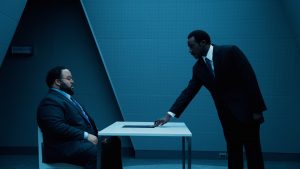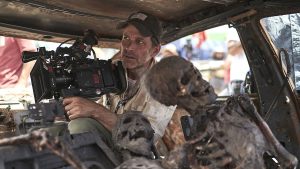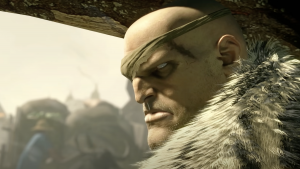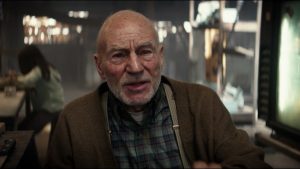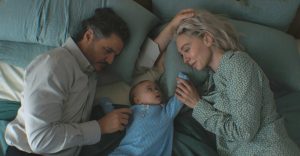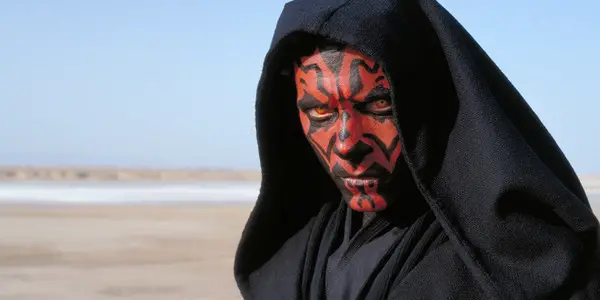
The first time I saw The Phantom Menace was on a pirated VHS I bought from a convenience store in Cyprus. I bought a couple of copies of that and The Matrix and sold them at school. I never got to see it at the cinema as none of my friends wanted to go with me and, being 15, I didn’t want to go by myself.
Pirated VHS’ in the late 90s were camcorder in the cinema jobs with crowd noises, shadows blocking the screen when someone stood up to go to the bathroom, and pisspoor audio and video.
I remember quite vividly that it was the first time I had ever been hyped by a movie and let down. Other movies that I had been obsessed with like Jurassic Park and Independence Day had been worth the wait and more, but when I watched The Phantom Menace, I had this feeling in my gut the entire time that, at that point in my life, I couldn’t name.
Now, I know it’s just the feeling of watching a bad movie you hoped would be good. I’m sure there’s a cool word for it in a foreign language but nothing snappy in English comes to mind. As you get older that feeling happens more and more as your tastes evolve and you build up a bigger resume of great movies but in 1999, I didn’t know what it was so when the movie ended, I said, “I loved it!” and sang its praises.
source: 2oth Century Fox
And then the years went by, and I heard more criticisms of the movie that matched my own feelings, and I realized that The Phantom Menace was a disappointment with no main character, unfunny humor, and annoying characters.
And then I did the same thing with Attack of the Clones. Watched it, loved it, and then realized later it wasn’t that good. And finally, I watched Revenge of the Sith and hated it only to rewatch it in preparation for the sequel trilogy and discover that it’s dope as hell, forming the first part of a wonderful trilogy of movies: Revenge of the Sith – Rogue One – A New Hope.
Of course, all of this is subjective and when I say a movie isn’t good it’s not gospel, it’s just how I feel, and that feeling changes all the time. You only have to look at other Away from the Hype movies in this series to see that one man’s trash is another man’s treasure and sometimes it’s the same man.
My relationship with the Star Wars prequels has always been a bit strange. I wasn’t young enough for them to be my entry point to Star Wars so I don’t have those nostalgia goggles that those fans who are ten years younger than me have. I’m not too cynical to completely write them off either. I mean, I don’t like Attack of the Clones but I do love the 1940s detective movie plotline Obi-Wan Kenobi goes through and think George Lucas handles that part very well.
For its 25th anniversary, I’m finally going to see The Phantom Menace in the theatres and with this column, I’ll actually look at it critically rather than as something to watch when I’m doing a rewatch of the Skywalker Saga where it can feel like a homework assignment.
source: 20th Century Fox
For its 25th anniversary, I’m finally going to see The Phantom Menace in the theatres and with this column, I’ll actually look at it critically rather than as something to watch when I’m doing a rewatch of the Skywalker Saga where it can feel like a homework assignment.
1999 Sean watched The Phantom Menace on a VHS shown on a living room TV and 2024 Sean is going to make it up to him by watching it in IMAX 25 years away from the hype.
Star Wars: Episode I – The Phantom Menace
There have been 25 years of criticism for this movie. By all accounts, it killed Star Wars and ruined childhoods, and it quickly became an easy punchline when talking about bad movies i.e. something might be bad but is it Star Wars prequel bad?
I don’t want to rehash all of that too deeply so instead I want to focus on what works with this movie because while it isn’t a great movie it has lots of great parts. In fact, the main thing with The Phantom Menace that brings it down is the vast gulf between the great stuff and the bad stuff.
I can’t think of another movie that only traffics in high highs and low lows with nothing in between. A bad movie might have one incredible scene (e.g. the opening scene of The Bonfire of the Vanities) or a great movie might contain some trash (e.g. Galadriel’s freak out in The Fellowship of the Ring), but The Phantom Menace somehow manages to only have two speeds: Awful and great.
For every wonderful acting performance containing nuance and subtlety from Liam Neeson, Pernilla August, and Ian McDiarmid, there are stilted line readings and actors who seem to have stepped straight out of an amateur dramatics club and onto the Tatooine set. It’s no secret that George Lucas isn’t an actor’s director. He’s a story and spectacle guy so it makes sense the older, more seasoned actors can make this work whereas the younger actors are seemingly left trying their best.
Natalie Portman and Jake Lloyd, a teen and a child during filming, have moments where they shine but sometimes, they both seem to be reading cue cards and could do with closer guidance and direction. Even Ewan McGregor struggles in places and it’s interesting to see the stilted Obi-Wan compared to the recent, excellent, Obi-Wan Kenobi where 20 years of additional acting experience come into play for an incredibly effective portrayal of the same character.
source: 20th Century Fox
Lucas’ focus on spectacle pays off though with incredible design work throughout. Every setting, costume and prop is meticulously created, and the cultures of the different planets feel thought-out and lived-in in that wonderful, scuffed-up Star Wars way that’s always been a big part of its appeal.
Multiple shots in this movie feel like they could be painted on canvas and hung on a wall: Padme in her red throne room gown waiting to be arrested, Qui-Gon and Obi-Wan standing on the Coruscant balcony with the flying traffic and sunset in the background, and any shot of the palace in Theed to name a few.
Along with spectacle, Lucas is a master of the big set-piece and this movie continues its theme by having some of the best alongside some of the worst of the saga. The climax has four action scenes all happening at the same time, cutting between them. The throne room infiltration is perfectly fine and mostly consists of gunfights before the baddies are tricked, and The Duel of the Fates lightsaber fight is one of the greatest moments in any Star Wars movie. This leaves the Gungan battle with the droids and the space battle in which Anakin accidentally blows up the target and poor Jake Lloyd is given some terrible dialogue.
There is a rule in writing that states you can have an annoying, unlikeable character but if you want the audience to bond with them, they have to be capable. For example, Sherlock Holmes in Sherlock is a rude jerk but he’s also brilliant so we’re happy to watch him. Author Brandon Sanderson talks about it as each character having three dials: likeability, capability, and proactivity. These are what makes a character interesting so if one dial such as likeability is low, you turn the others up to compensate.
source: 20th Century Fox
This brings us to Jar Jar Binks and the final battle. The problem with Jar Jar is that all three of his dials are low but Lucas is banking on the audience really, really liking the character to the point where Jar Jar’s lack of agency and ability won’t matter. Unfortunately, that is not the case.
For helping to unite the Naboo and the Gungans, Jar Jar is made a general and sent to the front lines where he engages in a bunch of slapstick nonsense before surrendering just in time for Anakin to destroy the droid common ship rendering the droids inactive.
Jar Jar doesn’t get a big hero moment where he overcomes his cowardice and clumsiness. If anything, those traits are heightened as he manages to evade death and injury purely by accident until someone else saves the day. The character we meet at the start of the movie and the character we meet at the end are the same with no growth at all.
Now we don’t know Lucas’ original plans for Jar Jar in the prequel trilogy as it seems as though the character is quickly sidelined from this movie onwards but even if the plan was for him to go on a big character journey over the three movies, the seeds need to be planted in this opener. As it is now, a viewer would either think we’re never going to see this character again or they’re going to appear in every movie as a lucky pain in the ass.
His lack of agency and talent has led to the fan theory that he must be a Sith lord in a vain attempt to give meaning and purpose to a character without either.
While Jar Jar is bouncing his way around the battlefield, Qui-Gon and Obi-Wan are fighting Darth Maul in one of the best sequences in Star Wars. The character design for Darth Maul is next level with the make-up, the horns, the black samurai-style clothes, and the double lightsaber make him such a memorable character that The Clone Wars TV show had to bring him back to life because we needed much more Maul.
source: 20th Century Fox
The acrobatic, almost balletic, lightsaber fight is played out in a setting that doesn’t a hundred per cent make sense. Are they in a reactor? A factory? Who cares? Because once that John Williams music kicks in, it doesn’t matter. Duel of the Fates, a piece of music as synonymous with Star Wars as The Imperial March, is just an incredible, goose-bump-causing track that I’m always shocked doesn’t feature in more Star Wars. It’s so iconic, that Colin Trevorrow named his eventually cancelled Star Wars movie after it.
While The Duel of the Fates is universally beloved, the other massive set piece of this movie, the podrace, is very divisive. Full disclosure, I love the podrace. I love every part of it from the gorgeous shots of the flags being presented on the track to the incredible Ben Burtt sound design to Greg Proops’ incredible turn as race commentator, Fode.
When this movie was released in theatres, critics complained that the podrace was too long and basically added nothing to the movie, so what did George Lucas do when the movie was released on DVD? He added more scenes to the podrace and made it longer. And he was right because it’s awesome.
Plot-wise it serves as the climax to the Tatooine section of the movie and provides the means for Anakin to leave with Qui-Gon. It also gives Anakin a big hero sequence and for little kids watching this, I imagine seeing a 9-year-old fly a supercharged spaceship/drag racer thing at high speed would be a dream come true. I was going to show this scene to my toddler as a litmus test, but I realised that if he liked it, I’d be asked to show it to him all day every day, and I can’t live like that.
source: 20th Century Fox
The podrace scene’s other possible purpose is that in A New Hope when Obi-Wan talks about Anakin he says that Anakin was already a great pilot when he met him. A hard needle to thread when you’re introducing your character as a 9-year-old but the podrace, even if Obi-Wan isn’t present for it, does the job.
Conclusion
George Lucas has never really cared for the strict dogma of screenwriting rules. Consider that in 1977, Star Wars, before it was Episode IV – A New Hope, was a one-and-done, not the beginning of a trilogy or the middle of a saga. Lucas always talks about having planned out the trilogy and written enough script for Star Wars that he had plotted out twelve movies, etc. etc. but also consider he has Leia kiss Luke and then the next movie makes them siblings.
A screenwriting (or any writing) rule that everyone knows is Chekov’s gun i.e. if you show a gun in the first act, you must fire it by the third. In A New Hope, Lucas shows us a lightsaber in the first act and Luke’s possession of it, and that’s it. Luke never even encounters the main villain, never uses the lightsaber to get the heroes out of a jam, and only uses it once for a brief training sequence.
Twitter in 1977 would have hated that.
source: 20th Century Fox
So, when critics complain about things like the podrace not adding anything to the narrative or the lack of a clear main character, I have to wonder what they expected from Lucas, a man who makes what he wants to make.
Also, for those complaining that there’s no main character, it’s Qui-Gon Jinn.
He has the most screen time and dictates all of the hero’s actions and movements. He’s the one who meets Jar Jar and Anakin, the one who gets anything close to a romantic subplot (there definitely feels like something happened between him and Shmi while they hid from the storm), and he’s the one who sets the entire saga in motion by insisting Anakin be trained.
I’m not sure if people who make the no main character complaint are just pissed that Obi-Wan isn’t the lead or if they’ve watched too many long Youtube critiques, but watching this movie this time with my critic hat on, it was clear that this is Qui-Gon’s story and one of the tragic what ifs we’re left with is could Qui-Gon have kept Anakin away from the dark side?
Overall, The Phantom Menace is an odd creature. It has aged very well in terms of filmmaking. The visuals and the effects still hold up and the usual hallmarks of a Lucas Star Wars: the design, the sound, and the music, are all present and correct.
But so are the original problems. Sometimes the movie’s editing is jarring and scenes last too long or cut too soon, the acting is sometimes great, sometimes painfully wooden, and the comedic elements mostly fall flat. Lucas’ defence of Jar Jar and some of the cornier Anakin stuff is that Star Wars has always been a movie for children doesn’t really work when A New Hope didn’t need anything like that to be a huge success with children and adults alike.
I have come to love this movie as I know a lot of other Star Wars fans have too. It has a lot of charm and it’s refreshing to see something playing by its own rules and not following a rigid formula. And also, that podrace scene is just such an undeniable banger that it actually made me feel a bit nauseated watching it in IMAX. And if that’s not a solid gold seal of approval I don’t know what is.
Does content like this matter to you?
Become a Member and support film journalism. Unlock access to all of Film Inquiry`s great articles. Join a community of like-minded readers who are passionate about cinema – get access to our private members Network, give back to independent filmmakers, and more.

